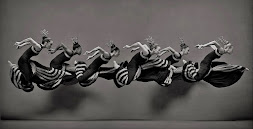Martha Graham - a pioneer. 'The Mother of American Modern Dance'
"The body says what words cannot"
Martha Graham was born in Allegheny, Pennsylvania on the 11th of May 1894 and passed away on the 1st of April 1991, at the age of 96.
Her Father was a physician and had an interest in "the bodily expression of human behaviour", with expression later becoming a key aspect of her dance style. When Graham was 16, her Father brought her to see a performance by Ruth Saint Denis, and she realised then that she wanted to be a dancer. Her Family moved to California in 1909, and it was there that Graham became familiar with Asian art which later had an influence on her choreography. She also took an interest in the sea and its fluidity and freedom, both important characteristics of her dance style, and her expressive and free movements were largely inspired by the nature she observed in Santa Barbara.
At this time, dance was considered a lower art form, and only ballet was considered prestigious and proper. However, modern dance was created to rebel against ballet and break the rules, and self expression took priority over technique and discipline. Martha Graham believed that dance could and should explore and express human spirit and emotion just as well as the spoken word. She wanted dance to be able to tell a story and have true inner feeling behind it, and express on the outside how she felt inside.
Her modern style of dance was created through experimentation and was extremely different to ballet - for example the use of bare and flexed feet rather than point shoes, the use of parallel feet rather than turned out, and the use of gravity and grounded movement which contrasted the light elevation of ballet. The movements came from within, like contraction and release, which had power and feeling behind them and their distortion (another key aspect of modern dance) juxtaposed the vertical neatness of ballet.
The Graham Technique - Martha Graham codified a system which consisted of different exercises to train dancers in her style. This allowed for the revolution of modern dance to flourish. The key aspects of this technique were:
- Contraction and release
- Breathing and how it affects movement
- The use of gravity, space and the floor
- Every movement must have a clear meaning and purpose behind it
- The inner self
- the spine, pelvis and stomach
"the personification of grief itself"
A haunting dance, representing grief and mourning through a physical form.
Heretic, 1929
follows the theme of an outsider or rebel, who's feelings differ from the majority.
"one against many"
Night Journey, 1947
A passionate and emotion-centred retelling of Sophocles' tragedy, Oedipus, yet with his Mother Jocasta at the centre of the story.
Key themes: Death, passion and sexual desire, love









Comments
Post a Comment